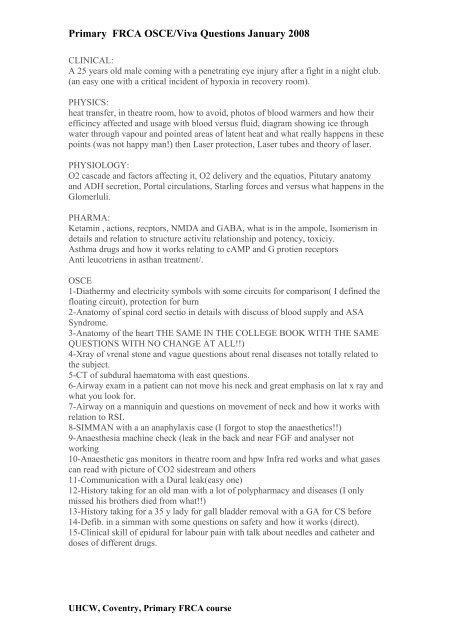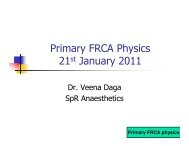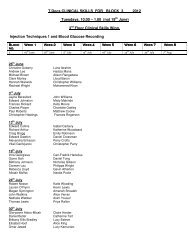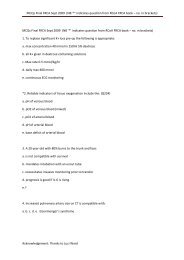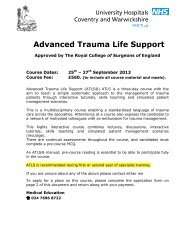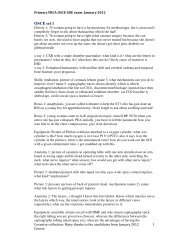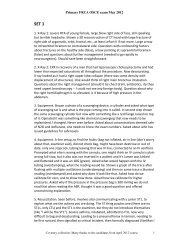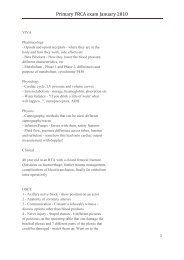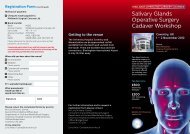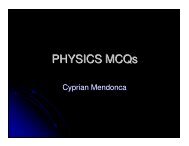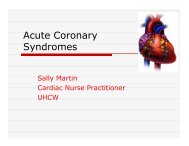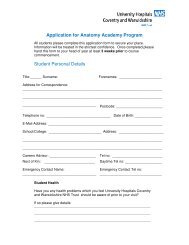Primary FRCA OSCE/Viva Questions January 2008
Primary FRCA OSCE/Viva Questions January 2008
Primary FRCA OSCE/Viva Questions January 2008
You also want an ePaper? Increase the reach of your titles
YUMPU automatically turns print PDFs into web optimized ePapers that Google loves.
<strong>Primary</strong> <strong>FRCA</strong> <strong>OSCE</strong>/<strong>Viva</strong> <strong>Questions</strong> <strong>January</strong> <strong>2008</strong>CLINICAL:A 25 years old male coming with a penetrating eye injury after a fight in a night club.(an easy one with a critical incident of hypoxia in recovery room).PHYSICS:heat transfer, in theatre room, how to avoid, photos of blood warmers and how theirefficincy affected and usage with blood versus fluid, diagram showing ice throughwater through vapour and pointed areas of latent heat and what really happens in thesepoints (was not happy man!) then Laser protection, Laser tubes and theory of laser.PHYSIOLOGY:O2 cascade and factors affecting it, O2 delivery and the equatios, Pitutary anatomyand ADH secretion, Portal circulations, Starling forces and versus what happens in theGlomerluli.PHARMA:Ketamin , actions, recptors, NMDA and GABA, what is in the ampole, Isomerism indetails and relation to structure activitu relationship and potency, toxiciy.Asthma drugs and how it works relating to cAMP and G protien receptorsAnti leucotriens in asthan treatment/.<strong>OSCE</strong>1-Diathermy and electricity symbols with some circuits for comparison( I defined thefloating circuit), protection for burn2-Anatomy of spinal cord sectio in details with discuss of blood supply and ASASyndrome.3-Anatomy of the heart THE SAME IN THE COLLEGE BOOK WITH THE SAMEQUESTIONS WITH NO CHANGE AT ALL!!)4-Xray of vrenal stone and vague questions about renal diseases not totally related tothe subject.5-CT of subdural haematoma with east questions.6-Airway exam in a patient can not move his neck and great emphasis on lat x ray andwhat you look for.7-Airway on a manniquin and questions on movement of neck and how it works withrelation to RSI.8-SIMMAN with a an anaphylaxis case (I forgot to stop the anaesthetics!!)9-Anaesthesia machine check (leak in the back and near FGF and analyser notworking10-Anaesthetic gas monitors in theatre room and hpw Infra red works and what gasescan read with picture of CO2 sidestream and others11-Communication with a Dural leak(easy one)12-History taking for an old man with a lot of polypharmacy and diseases (I onlymissed his brothers died from what!!)13-History taking for a 35 y lady for gall bladder removal with a GA for CS before14-Defib. in a simman with some questions on safety and how it works (direct).15-Clinical skill of epidural for labour pain with talk about needles and catheter anddoses of different drugs.UHCW, Coventry, <strong>Primary</strong> <strong>FRCA</strong> course
<strong>Primary</strong> <strong>FRCA</strong> <strong>OSCE</strong>/<strong>Viva</strong> <strong>Questions</strong> <strong>January</strong> <strong>2008</strong><strong>OSCE</strong> STATIONS:1) Anatomy of Trachea, Bronchi, Lungs and Pleura – asked in detail aboutbronchi, broncho-pulmonary segments and pleura2) Anatomy of the Orbit, Skull foramina, Peribulbar block3) Intra-osseous needle – Indications, technique, contra-indications andcomplications, fluid management in children4) Peripheral nerve stimulator – sites, all modes of stimulation, Phase II Block5) Bain Circuit – assembly, checking, Dynamics of gas flow, soe ETCo2 traces6) Sim man – ITU patient with h/o difficult intubation with dislodgedtracheostomy tube ( 2 days old tracheostomy)7) Sim man CPR – VF shockable rhythm – demonstrate delivery of shock,administration of drugs8) Microshock – possible routes in the theatre, earthing of the electric equipment,some electric symbols9) CPR in Asystole – DISCUSSION ONLY of the ALS Protocol10)Thermistor – physical principles, uses, methods of peri-operative temperaturemaintenance11)Epidural Catheter – checking before use. (The outer packaging was deliberatelytorn and kept)12)Communication – Young Lady posted for Appendictomy. Past h/o Heroinaddiction, currently on Methadone. Concerned about using Morphine. Counsel her.13)Take history from a Zimbabwean Lady for pelvic laparoscopy – fever, cough,weight loss, menorrhagia, Not tested for Hbs,14)Lady with ALL on Chemotherapy for Hickman Line insertion under GA – HistoryOnly – h/o Pneumothorax after previous attempt at Hickman Line insertion., PONV15)Complete CNS Examination in a Head Injured patient.16) X-ray contrast Pulmonary Angiogram showing RPA Embolus17) Barium swallow showing a Pharyngeal web/ Post cricoid web.PHYSIOLOGY VIVA:1) Hypoxia – types, Oxy Hb dissociation curve and the effects of the types ofHypoxia on it.2) Cardiac Cycle3) Mono/poly-synaptic reflex, muscle spindle anatomy, compound AP,Excitation contraction couplingPHARACOLOGY VIVA:1) Bioavailabity – definition, factors affecting it, how will you find out thebioavailability of a orally administered drug, extraction ratio, hepaticclearance.2) Antibiotics – classification and mechanism of action of each class, mechanismof drug resistance, Drugs for MRSA and Pseudomonas infection, side effectsof penicillin.3) Opioids – Molecular Mechanism of action (beyond receptors), distribution ofthe receptors, Effects on the various organ systemUHCW, Coventry, <strong>Primary</strong> <strong>FRCA</strong> course
<strong>Primary</strong> <strong>FRCA</strong> <strong>OSCE</strong>/<strong>Viva</strong> <strong>Questions</strong> <strong>January</strong> <strong>2008</strong>PHYSICS VIVA:1) NIBP – all the methods with their physical principles and IBP2) Flows in cannulas – laws governing them,3) Needles – epidural, filter, RBN, Vygon arterial cannula, factors affecting thedamping in a monitoring system4) H + estimation and its correlation with pH. pH electrode and HendersonHasselbalch Eqn.CLINICALS VIVA:22 years old gentleman brought to A+E by paramedics after RTA. Has fracture of theshaft of femur. c/o Chest pain, difficulty in breathing. o/E thready pulse. How willyou manage?Discussion about:D/D for thready pulseSources of bleedingManagement of Haemothorax, Pneumothorax, HaemoperitoneumFat EmbolismEstimation of peri-operative blood lossIndication for transfusion of blood and blood products<strong>OSCE</strong>:1.Sim Man - anaphylaxis2.Sim Man - cardioversion of VT3.Anatomy - brachial plexus + axillary nerve block4.Anatomy - transection of spinal cord (tracts, bloodsupply)5.Anatomy/physiology - cardiac and coronary withidentification of LCA on angiogram6.Procedural skills - labour epidural7.X-rays - CT brain (extradural haematoma)8.X-rays - AXR (staghorn renal calculus)9.Clinical - management of bradycardia10. History - Pre-hysterectomy11. History - Pre- left hemi12.Communication - History of post-labour epidural duralpuncture headache + management options13.Physics- entonox14.Physics - volatile agent measurement and capnography<strong>Viva</strong>s:Physiology:UHCW, Coventry, <strong>Primary</strong> <strong>FRCA</strong> course
<strong>Primary</strong> <strong>FRCA</strong> <strong>OSCE</strong>/<strong>Viva</strong> <strong>Questions</strong> <strong>January</strong> <strong>2008</strong>1.Oxyhaemoglobin dissociation curve, alveolar gasequation, PO2 at altitude and increased bariatric pressure2.Handling of glucose by the kidneys3.Action potentials- cardiac and nervePharmacology:1.Midazolam and GABA receptors2.Nicotinic and muscarinic receptors and drugs3.Organophosphate poisoningClinical:A lady scheduled for elective laparoscopic cholecystectomywho can only open her mouth 2 fingers breadth- discussmanagement. She developed a severe anaphylaxis during thecase. Prevention/treatment of PONV.Physics:1.Venturi principle and applications2.Definitions of absolulte/relative humidity, measurementof humidity (regnaults, wet/dry bulb, hair, massspectrometry), importance of humidity.3.Measurement of volatile agents and CO2.physics and clinical1. pt was 23yr old female with asthma. she was booked for elective tonsillectomy.clinical incident was i knocked her tooth out.2. blood pressure and describe invasive technique and trace3. sterilization/ disinfection - showed autoclaved pics of lmas - had to know whichhad been autoclaved by looking at outside packaging.4. warming fluid and the thermostatphysics and pharmacology1. pressure vol loops for left ventricle and what happens if more fluid, or ionotropesetc2. intracerebral fluid - what is it, uses, pressure where produced, contents bufferingcapacity. how is it useful in altitue response.3. given 1l saline iv what happens?4. local anaesthetics - what determines potency, onset etc and what happens in a pusfilled wound.5. stats - p value, null hypothesis. if p
<strong>Primary</strong> <strong>FRCA</strong> <strong>OSCE</strong>/<strong>Viva</strong> <strong>Questions</strong> <strong>January</strong> <strong>2008</strong>base of skull - sof and optic canal, how to perform eye blocklaser tubeexamine jvpexplain to relative father having emergency aaa repairpost lap chole called to ward - given rhytmn strip - sinus tachy - what do you dosafe defibrillationput leads in cm5 configuration and then speed of ecg and amplitude etchistory, man for septoplastysimman - endo broncial intubationtrain of four, put electrodes on for ulnar twitchfollow on history - woman with graves having sub total thyroidectiomycheck all equiptment for rsioxygen measurement - para, fuel cell and clark - identify which is which and explainhow pauling works.2 lateral chest xrays - one middle lobe pneumonia, other gas under diaphragm.cross section of spine - only one side marked and not told if ascending or descending -VERY BAD question<strong>OSCE</strong> Stations1. Pulse Oximeter: identification, usage, principles and problems.2. SVT: Rhythm strip shown. Identify, treatment depending on stability.3. History: Varicose veins surgery. Pt with Asthma who had been ventilated.4. Sinman: Can’t intubate, can’t ventilate scenario. Crico-thyroid punctureperformed.5. CXR: Sacroid in a 35 year-old man. 10 true-false.6. Anatomy. Identify vertebrae: C1/C2 vertebrae and then further discussionregarding anatomy of spinal cord. Eg: identify the inter-vertebral space, andfacet joints.7. Subclavian line: describe anatomy, relations of SC vein. How would youperform a right SCV central line insertion. Complications.8. History station: Dental extraction . Pt has cutaneous prophyria.9. Follow-on station: question regarding: What operation, what co-morbidities,exacerbating factors, occupation, one question on what is the disease.UHCW, Coventry, <strong>Primary</strong> <strong>FRCA</strong> course
<strong>Primary</strong> <strong>FRCA</strong> <strong>OSCE</strong>/<strong>Viva</strong> <strong>Questions</strong> <strong>January</strong> <strong>2008</strong>10. Check a Bain System.11. X-ray: Thyroid swelling.12. Methods of oxygen analysis. Fuel cell, Clarke electrode and Paramagenticanalyser: Identify them from schematic diagrams. Labelling of Clarkeelectrode and Fuel cell.13. Cricoid Pressure. Demonstrate, indications, anatomical level, principle behindit, complications.14. Sinman: Bradycardia & hypotension during Lap cholecystectomy. Essentialpt develops VT following Atropine and Adrenaline. Have to DC cardiovert.Ensuring synchronisation.15. Ankle anatomy and ankle blocks.16. CVS examination17. Nerve injury. Pictures and them asking which nerve would be injured,assessment of nerve injury. What does the circumflex nerve supply and whatis its origin and route.18. Communication station: Counsel a p for an awake fibro-optic intubation.VIVA’sPhysiology:Describe and quantify typical values for CO/BP/HR/CVP. Describewhat happens to them during blood loss.What is shunt? <strong>Questions</strong> related to that.Describe how glucose, sodium and water are absorbed in the PCT.What is inulin and how is that excreted?PharmacologyUHCW, Coventry, <strong>Primary</strong> <strong>FRCA</strong> course
<strong>Primary</strong> <strong>FRCA</strong> <strong>OSCE</strong>/<strong>Viva</strong> <strong>Questions</strong> <strong>January</strong> <strong>2008</strong>Local AnaestheticsHenderson-Hasselbank equationAnti-emeticsHalf-life, plasma conc against time. Two compartment models.Clinical:11 year-old afro-caribbean boy admitted to A&E with painful testicle.Surgeons want to operate immediately. No investigations available.Discussion focused around sicke-cell disease, diagnosis, pre-, intra andpost-op management.Critical incident was Laryngospasm.PhysicsPhysiologySI UnitsHumidity, and devices used to humidify.Neuromuscular junction monitoring.Draw graph for intraalveolar pressure with time and intrapleural pressure change withtime with inspiration and expiration.Effect of IPPV on respiratory and cardiovascular system.How is Thyroid hormone synthesised, mechanism of action, and regulation of thyroidhormone in body.Other hormone synthesised by thyroid (calcitonin), mechanism of action.Cerebral blood flow how is it regulated and graphs for patient with hypertension.PharmacologyPropofolCompare and contrast propofol with thiopentoneDrug metabolism Phase I and phase II reactions and Cytochrome P450 mechanismsignificance of drug metabolism with examples. Inducers and inhibitors and theresignificance.UHCW, Coventry, <strong>Primary</strong> <strong>FRCA</strong> course
<strong>Primary</strong> <strong>FRCA</strong> <strong>OSCE</strong>/<strong>Viva</strong> <strong>Questions</strong> <strong>January</strong> <strong>2008</strong>Adrenoreceptors: - Types and Mechanism of action. Examples and sites of thesereceptors.ClinicalA 75 year old lady for elective THR. She has got long standing rheumatoid arthritis.What are the issues with her in regard to the anaesthetic management? Elaborate onthe various system involvements.Critical incidentTotal SpinalPostoperative pain management in the patients of THR advantages and disadvantagesassociated the technique used.PhysicsWhat are transducers? What are different types? Draw diagram of transducer straingauge. Draw Wheatstone bridge.What is critical incident? What is calibration and three graphs for interpretationLinear, Offset and gradient drift.What is Minimal Mandatory monitoring? What are all the alarms and which alarmgoes off first if the patient gets disconnected.<strong>OSCE</strong>1. O2 analyser’s three diagrams and questions on fuel cell, Clark electrode andPara magnetism.2. Cricoid pressure3. How will you perform ankle block on an actor and distribution of the sensorysupply on the leg and the dorsum of the foot.4. Resuscitation station bradycardia and then goes on to ventricular fibrillation5. Resuscitation station only questions on narrow complex tachycardia6. History taking for a male coming in for stripping of varicose veins7. Cardiovascular system examination8. Sim man Unable to intubate and ventilate and cricothyroidotomy9. X-ray chest with 10 questions to follow lady for a thyroid operation havingtracheomalacia/deviated trachea on x-ray.10. X ray of chest and 10 questions11. Demonstrate Cannulation of subclavian vein12. Machine check bains circuit13. Follow on station with a person with porphyria cutanea tarda.14. Anatomy of spinal cord along with the vertebrae atlas, axis.15. Communication station Fibreoptic intubation in a lady with difficult intubationlast time16. Pulse oximetry and O2 dissociation curves for haemoglobin and myoglobinUHCW, Coventry, <strong>Primary</strong> <strong>FRCA</strong> course
<strong>Primary</strong> <strong>FRCA</strong> <strong>OSCE</strong>/<strong>Viva</strong> <strong>Questions</strong> <strong>January</strong> <strong>2008</strong>17. Injury to the nerves in patient positioning and methods of decreasing theinjuries. Areas supplied by median nerve, ulnar nerve and radial nerve.My questions:PhysiologyCardiac pressure/volume curveChanges to After and preload and how they would change the curveHow a change in compliance and contractility would alter the curve.CSF: how it is formed and reabsorbedConstituents and concentrationsFunctionsWhat happens on infusion a litre of fluid.PharmacologyLocal anaesthetics: types, chemical structure of ester and amidesHow they are metabolisedExamples of eachWhat was the first local anaesthetic agentWhat alters onset/offset etcSafe dosagesAntihypertensivesTypesTell me more about ACE inhibitors etcStatistics (as part of pharmacology) - very unexpectedWhat types of data are thereWhat types of statistical analysis can we do (examples of parametric and nonparametric tests)What is the Null HypothesisWhat is the power of a studyClinical58 year old man for TURP, known dyspnoea and angina - Aortic stenosis withgradient of 30mmHgDiscussion about how i'd manage him - pre, peri and post operativeDiscussion re spinal versus GADiscussion about cardiac referrals etcClinical incident : patient in recovery drowsy and possible reasons leading into TURPsyndromePhysicsPicture of a vaporiser : types, how they work, des vaporisorPicture of scavenging : types, pollution levels, etcPicture of ultrasound machine: how does it generate ultrasound, detect it, piezoelectricphysicsUHCW, Coventry, <strong>Primary</strong> <strong>FRCA</strong> course
<strong>Primary</strong> <strong>FRCA</strong> <strong>OSCE</strong>/<strong>Viva</strong> <strong>Questions</strong> <strong>January</strong> <strong>2008</strong>Doppler effect, what is it etc<strong>OSCE</strong>:Transection of spinal cord - name tracts and where blood supply from, what happensin anterior spinal arter syndromeOxygen analysis - clark and fuel cells and label the diagram, paramagnetic analyserRSI - what equipment is required, asked to check the equipment (quite amusing - themagills were stuck together, the laryngoscope had no battery etc)Two stations on radiology - both were questions on a lateral CXR - unexpectedDemonstrate how to do a cricothyroidotomyResus station with defib - man in fast AF acutely with SBP of 70History - hyperthyroid woman for thyroidectomyHistory - man for nasal surgery with Obstructive Sleep ApnoeaCommunication - lady who's father rushed into AAA repair, discussResus station - called to ITU by ST1 , man back from theatre after lap chole,desaturating with type 1 failure on gaeses, tube in to 28 cm and crackles over bothsides once pulled back - had aspirated in theatreDiscussion of skull: what two things pass through cribiform plate (still only knowone), through optic canal and superior orbital fissure.Examination of JVPDodgy station on ECG trace - talking about where to put leads for CM5, aboutfiltering on ECG trace and 'spot the differences' between non filtered and filtered ECGtrace. Got the feeling this was a test station.Lasers - what it stands for, safety , what used for.Hope this helps,Thanks again,PS - if you have any cancellation for the airway course in Feb please let me know, ihave the day off anyway so could come at short notice and am really interested.<strong>OSCE</strong>1) RESUS 1NARROW COMPLEX TACHYCARDIA –ALS PROTOCOL 10 questions2) RESUS 2BRADYCARDIA protocol after giving adrenaline ON A SIMMAN WENTV TACH EXPECTED US TO SHOCK AND ALS PROTOCOL3) Communication66 year old lady previous difficult intubation,explain awake fibreopticintubation4) HistoryVaricose veins stripping asthmatic,eczema5) anatomy of ankle joint and block6) Anaesthetic hazardsUlnar nerve damage and circumflex humeral nerve damage photos7) EquipmentFuel cell8) AnatomyUHCW, Coventry, <strong>Primary</strong> <strong>FRCA</strong> course
<strong>Primary</strong> <strong>FRCA</strong> <strong>OSCE</strong>/<strong>Viva</strong> <strong>Questions</strong> <strong>January</strong> <strong>2008</strong>All vertebrae 15 questions9) Sim manCVCI10) Machine checkBains circuit11) ProcedureSellicks manourvere 10 questions12) ProcedureSubclavian vein cannulation13) Xray 1COPD 10 questions14)Xray 2Ap view neck thyroid ---10 questions15 ,16) follow onTb previous lobectomy ,arthroplasty of wrist joints on steroids methotrexate<strong>Viva</strong>Physics : pulsoximeter,pressure regulator,mathematical curvesClinical:82 year old turp hypertensive ,ccf .critical incident hypoxemia TURPsyndromePhysiology; BMR,ABG analysis, control of respiration,action potentialsPharm: nsaids,digoxin,protein bindingPRIMARY <strong>FRCA</strong> Jan 23 rd <strong>2008</strong><strong>OSCE</strong>1. NMJ monitoring – TOF, TET, DBS; where to place electrodes, current, freq,muscles innervated by ulnar nerve2. Pre-history station – TAH for mennorhagia, previous awareness with em. C/S3. History presentation and questions4. X-ray – lateral CXR with hiatus hernia5. Equipment check pre-RSI – various items obviously sabotaged, discussion ofmachine check etc6. Label tracts of spinal cord7. Methods of O2 analysis – paramagnetic, fuel cell, how they work8. Awake cricothyroidotomy – “explain to ST1 how to perform thisprocedure” (difficult examiner, not sure what she wanted, everybody struggled)9. Anatomy – base of skull and orbit, peribulbar block10. Simman - fast AF with hypotension under GA, cardioversion etc.11. ECG – how do they work? CM5 arrangement, voltage etc12. Post-op. resus scenario – discussion only, cardiac arrest protocol/PEA post lapchole, causes13. Comm skills – explain to relative about father in theatre with ruptured AAA14. History station – pt for septoplastywith symptoms of OSA15. Examine JVP – discussion about waves etc16. Simman – endobronchial tubeUHCW, Coventry, <strong>Primary</strong> <strong>FRCA</strong> course
<strong>Primary</strong> <strong>FRCA</strong> <strong>OSCE</strong>/<strong>Viva</strong> <strong>Questions</strong> <strong>January</strong> <strong>2008</strong>17. X-ray – another lateral CXR!18. Lasers – types, uses, how they work, tubes/precautions in thaetreVIVAS1. Phys & Pharm.- routes of drug admin, factors affecting absorption, bioavailability, transdermalpreparations- anticholinesterases – draw NMJ, uses, classify, mode of action, side-effects- diuretics – draw nephron, sites and modes of action, side-effects- Aortic/LV pressures/ cardiac cycle diagrams- LV pressure-volume loop- Coagulation cascade- Fibrinolysis2. Clinical & Physics- type 1 diabetic aged 68 for urgent BKA- septic, oliguric, acidotic, ?DKA- straight-forward discussion of pre-op assessment and optimisation- anaesthetic options: pros and cons of regional vs GA- explain spinal and epidural- critical incident: fitting in recovery – management, differential, treatment of LAtoxicity- temperature measurement- vapourisers- biological signals – voltages, frequencies, amplification, interference etc( tricky)- <strong>OSCE</strong>- Station 1 – Axillary Nerve Block-- Demonstrate on person how you would perform an axillary nerve block- What nerves may be missed- What part of the plexus are you aiming at- Picture of dermatomes – what nerves supply each dermatome-- Station 2 – Spinal cord anatomy- Diagram of a cross section of a spinal cord with ganglion to label- What cells are in grey matter?- What asc/desc tracts are labelled- What symptoms/signs from a transection of the cord-- Station 3 – Communication PDPH-- Station 4 – Difficult Airway- “Assess this man’s airway”- What investigations would you like – XR C spine to interpret-- Station 5 – DiathermyUHCW, Coventry, <strong>Primary</strong> <strong>FRCA</strong> course
<strong>Primary</strong> <strong>FRCA</strong> <strong>OSCE</strong>/<strong>Viva</strong> <strong>Questions</strong> <strong>January</strong> <strong>2008</strong>- Pacemaker – what is VVI- Diathermy + pacemaker issues- Diathermy safety- 4 wave patterns – which is for cutting/coag-- Station 6 – Difib safety- Walk in – pt in theatre, VT on monitor, what would you do?- <strong>Questions</strong> on Mx of arrhythmias-- Station 7 – Gas analysis- What methods can be used to measure gases- Why is Fi/ET nitrous the same but Iso is different- In what clinical setting would the ET Iso be higher than set on the vaporiser-- Station 8 – Bradycardia- ECG strip- Causes of bradycardia- Management- Adverse signs- Risk of asystole-- Station 9 – History Taking- Hysterectomy-- Station 10 – Simman- Anaphylaxis-- Station 11 – CT head (unmanned)- Diagnosis, is there midline shift? Is there a #?-- Station 12 – Epidural- Show on the patient where and talk through how you would insert an epidural- How far to insert catheter-- Station 13 Coronary Anatomy- Angio of LCA- Where do the coronary arteries arise from, where do the veins drain into-- Station 14 – History (a)- Man for hemicolectomy ?ca, AF, MI-- Station 15 – History follow on-- Station 16 – AXR- Staghorn calculus, pt on anti TB meds- 10 T/F Qs –- this pt would benefit from steroids- this pt is at increased risk of unwanted pregnancy-- Station 17 – Machine CheckUHCW, Coventry, <strong>Primary</strong> <strong>FRCA</strong> course
<strong>Primary</strong> <strong>FRCA</strong> <strong>OSCE</strong>/<strong>Viva</strong> <strong>Questions</strong> <strong>January</strong> <strong>2008</strong>- O2 analyser not working, no connection at common gas outlet,-- Station 18 – Entonox- 2 stage demand valve, questions on CT/pressures in cylinder, hypoxic mixture--- <strong>Viva</strong>s- SOE 1 (physiology/pharmacology)-- Draw the oxygen Hb dissociation curve- Calculate oxygen content at sea level and at altitude- Nerve action potentials – duration, membrane potentials, what causes the potentialto reach threshold- Muscarinic/nicotinic receptors, where are they, what do they do, ag/antag at each-- Benzos – different types of receptor, metabolism, discussion about midazolam- Dose response curves – why we use them-- SOE 2 (physics/clinical)- Anaphylaxis-- Gas analysis – CO2 – mainstream/sidestream- How IR is used to measure gases- Humidity – Regnault’s hygrometer, humidity/temp relationsUHCW, Coventry, <strong>Primary</strong> <strong>FRCA</strong> course


